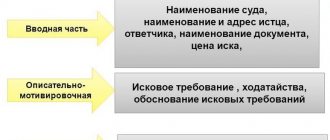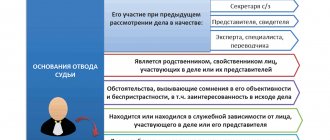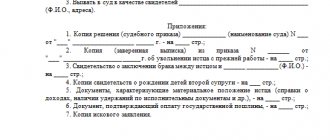How does changing the requirements for a claim differ from clarification?
Current rules of procedural law use two terms applicable to the plaintiff's claims: clarification and change. They are different, but are often used interchangeably by lawyers. The first concept is revealed in Art. 149 Code of Civil Procedure of the Russian Federation. Its essence is that in preparation for the trial, the applicant hands over materials to the defendant for review. The latter has the right to clarify unclear points regarding the stated wishes and argumentation.
The concept of clarifying claims in civil proceedings is not used in relation to a situation where the defendant has already become familiar with the case materials and the proceedings have begun. However, in a broader interpretation, essential adjustments are also called clarification.
Comments on legislation
Full description
Arbitration and civil procedural legislation contains a considerable number of dispositive norms, the essence of which is that they do not directly predetermine the behavior of the subjects of the process and allow them to act at their own discretion. For example, in accordance with Article 39 of the Civil Procedure Code of the Russian Federation, the plaintiff has the right to change the basis or subject of the claim, increase or decrease the amount of the claim, or abandon the claim, the defendant has the right to admit the claim, the parties can end the case with an amicable agreement. A similar norm is contained in the Arbitration Procedure Code of the Russian Federation (Article 49).
When reading these provisions of the law, one cannot help but think about the similarity of the legal nature of the reduction of claims and the waiver of a claim, and in particular, a partial waiver. Is this really true?
Let's imagine a situation: the plaintiff goes to court demanding the recovery of 500,000 rubles, and then during the trial reduces the amount of the claim to 300,000 rubles. The question arises: is it possible to subsequently go to court again with a demand for the recovery of the same 200,000 rubles by which the initial demands were reduced? Neither the Code of Civil Procedure of the Russian Federation nor the Arbitration Procedure Code of the Russian Federation give a direct answer to the question posed.
The only source of information that may contain an answer to this question is current judicial practice. But even there there is no unified approach regarding the difference between the consequences of reducing claims and partially abandoning a claim.
Thus, the Second Arbitration Court of Appeal, having summarized judicial practice on the application of certain provisions of Article 49 of the Arbitration Procedure Code of the Russian Federation, came to the conclusion that there are two approaches to resolving the issue of the right of the arbitration court in the event that the plaintiff has declared a reduction in claims, to accept not a reduction in claims , but a partial waiver of the claim.
- The plaintiff’s right to reduce the claim corresponds to the obligation of the arbitration court to consider on the merits the clarified, rather than initially stated, claims, while the plaintiff’s right to a partial waiver of the claim is the obligation to terminate the proceedings in the relevant part, as well as to consider the merits of the claim, refusal from which it is not declared. As the court notes, these procedural decisions entail various legal consequences for the plaintiff, related, in particular, to the possibility of the plaintiff subsequently obtaining judicial protection in relation to claims not considered by the court. For example, if the court has considered a clarified claim, then the original claim in the unconsidered part may be brought again by the plaintiff to the court. Meanwhile, in the case where the court accepts a partial waiver of the claim, the claims in respect of which the court terminated the proceedings in the case cannot be the subject of consideration in another case. In this regard, when the plaintiff exercises the right to reduce claims, the arbitration court does not have the right to accept a partial waiver of the claim and terminate the proceedings.
- Along with the right to reduce the claims, the plaintiff has the right to abandon part of the claim. Moreover, in the event that the arbitration court establishes the possibility of accepting a waiver of part of the claim, the proceedings in the case in the relevant part are subject to termination. A reduction in claims, in fact, can be regarded as an actual waiver of part of the claim. Therefore, the reduction of claims, as well as a partial waiver of the claim, must be formalized by accepting a partial waiver of the claim and terminating the proceedings in part.
To determine which approach is correct, it is necessary to carry out an extensive analysis of judicial practice with the participation, in particular, of the highest courts of Russia.
For example, the Supreme Arbitration Court of the Russian Federation, in its ruling dated June 27, 2012 No. VAS 8025/12, emphasized that clarification of claims in accordance with Part 1 of Article 49 of the Arbitration Procedure Code of the Russian Federation does not give rise to the consequences provided for by law in connection with the plaintiff’s refusal of the claim.
This conclusion is also supported by the majority of lower arbitration courts.
- The FAS Povolzhsky District, in a resolution dated September 20, 2010 in case No. A06 225/2010, noted that a reduction in the amount of the claim by the plaintiff does not entail the termination of the proceedings, since this procedural action is not a waiver of the claim. In this regard, termination of proceedings in the case regarding the claims is possible if the plaintiff renounces the claim.
- The Federal Antimonopoly Service of the Ural District, in resolution dated November 30, 2009 No. F09-9458/09-C3 in case No. A60-7307/2009-C1, came to the conclusion that reducing the amount of claims in the manner provided for in Article 49 of the Arbitration Procedure Code of the Russian Federation does not entail termination proceedings in the case and the impossibility of re-applying to the court, since it does not constitute a waiver of the claim by the plaintiff.
Based on the above, most courts are inclined to the approach according to which a reduction in the amount of claims does not entail the termination of the proceedings and the impossibility of re-applying to the court, since it does not constitute a waiver of the claim by the plaintiff. The right of the plaintiff to reduce the amount of claims for a specific period when considering one case does not exclude the possibility of demanding their recovery in the future.
In conclusion, it is advisable to note that, despite the fact that the law directly provides for the consequences of abandoning a claim, however, it does not specify the differences in the legal consequences of this procedural action and the reduction of claims. But it is necessary to take into account that partial refusal of the claim and reduction of claims are the direct rights of the plaintiff, provided for by the rules of the Arbitration Procedure Code of the Russian Federation and the Code of Civil Procedure of the Russian Federation, therefore, a direct indication in the law of the differences in the consequences of their implementation will eliminate the need to resort to judicial practice, and will increase the level of understanding by the plaintiff of his rights during the judicial proceedings and, therefore, will serve the purposes of a fair hearing of the case.
Stepanov S.A.
Law firm Tyumen
Application Form
Filing a petition is permissible at any convenient time during the trial. Its author is not obliged to explain to the court the reasons for the decision.
Important! The law prohibits filing a new claim under the guise of clarification.
The petition to clarify the requirements contains the following information in the header:
- the name of the court receiving the appeal (it can be found on the official website of the justice authority);
- Full name of the author-compiler;
- his place of residence, contact telephone number;
- Full name and residential address of the defendant;
- cost of claim (not mandatory, but desirable).
Next, in the middle of the new line, the name of the document is written - “Change of claims.”
Features of the content of a petition to reduce claims
The form of the application is not established at the legislative level. Therefore, the plaintiff has the right to present his request in the way he sees fit to convey the information in full. It is recommended to use the rules applicable to drawing up a statement of claim as a guide.
The procedure for drawing up an application is not complicated; the preparation of the document does not require special knowledge and skills. However, if difficulties arise, it is recommended to seek help from a lawyer, because The final decision of the court depends on the quality of the information to be reflected in the text of the document.
The content of the application must include the following information:
- full name of the court to which the application is sent;
- information about all participants in the process;
- case number;
- the amount of claims initially specified in the claim; the amount by which the applicant considers it necessary to reduce them; final result;
- the reason for the decision to change the scope of requirements.
The structure of the application must contain the following blocks:
- "A cap". In this section it is necessary to indicate the name of the court to which the application is sent, information about the plaintiff and defendant.
- Main part. The plaintiff’s request should be substantiated by referring to the provisions of the law in accordance with which the petition is filed. It is necessary to determine the new value of the claim and provide detailed calculations of the amount of claims, as well as indicate the amount of adjustments made. Calculations can be included in the text of the document or attached to it as an appendix. For clarity, you can use graphs, tables, etc.
- List of attached documents. This may be any evidence at the discretion of the plaintiff, confirming the feasibility of his request.
- The date of the petition and the personal signature of the plaintiff or his authorized representative.
Attention! The petition must be drawn up in detail, taking into account the norms of current legislation. The content of the document must fully disclose the essence of the circumstances that led to the decision to make adjustments.
If you have any difficulties drafting a petition, use our 24-hour online legal advice.
Rules for filing a petition in court
Only two persons have the right to submit a petition to amend the statement of claim:
- the plaintiff himself;
- his legal representative.
Other persons participating in the process cannot make adjustments to the original claim. If the applicant refuses the previously stated demands against the defendant (in whole or on individual points), a petition to abandon the claim (in whole or in part) is drawn up.
Current legal regulations determine jurisdiction and jurisdiction to clarify the requirements for the claim. The appeal is sent to the court that is already considering a specific case, at any stage of the process. The law does not limit the number of petitions that one citizen can file during the period of litigation.
The court, having received an appeal from a participant in the hearing, adopts a reasoned ruling on his issue. In it, he sets out which demands are removed from the claim, which ones are added, and how the parties’ arguments change.
After clarification in the arbitration process, the next meeting may be postponed. In view of the emergence of new circumstances, the court has the right to invite the parties to look for additional evidence of their own innocence and to change the system of arguments used.
Government duty
Filing a claim, as a general rule, is accompanied by payment of the statutory fee. Its size is determined by the declared price of the claim.
Accordingly, if the size of the requirements decreases, the state duty should also be revised.
The Tax Code of the Russian Federation provides, accordingly, for the possibility of refunding the amount of the duty when considering a claim by district and arbitration courts. In each of these cases, the need to return part of the funds paid must be reflected in the court decision in this case.
Refusal to reduce requirements
In some cases, the law allows the court to apply certain restrictions. Thus, the arbitration court may not accept a reduction in the stated amount of claims if this action violates the law or infringes on the rights of other persons. We are talking here, as a rule, about mandatory payments.
As for district courts, the Code of Civil Procedure of the Russian Federation does not mention such powers of the courts specifically in cases of reduction in the value of the claim. It applies only when considering waivers, admissions and settlement agreements.
However, judicial practice shows that some situations can force the court to deny the plaintiff such a request. This is possible if another legal norm does not allow reducing the amount of funds collected.
An example would be alimony cases. Even if the plaintiff asks the court to reduce the amount initially claimed for recovery, the interests of minor children must be taken into account first. When such a reduction in payments significantly worsens the child’s situation compared to the guarantees of the legislator, the court has the right to refuse the plaintiff.
How to correctly determine the subject or basis of a claim
A person must understand that a correctly drawn up application determines whether the document will be accepted for consideration or not, as well as the amount of possible compensation.
It is necessary to act logically and build smooth conclusions. This will allow you to develop a specific algorithm of actions that will help you draw the appropriate conclusions:
Expert opinion
Mikhailov Igor Konstantinovich
Legal consultant with 10 years of experience. Specializes in the field of civil law. Has experience in document examination.
The claim must be based on some negative aspects, for example, they did not repay the debt, caused damage to property assets, or evaded payment of alimony.
The plaintiff will need to collect various certificates and papers from government agencies. In addition, it will be necessary to carry out laboratory diagnostics in specialized companies with special permission. The final conclusion is issued to the applicant in the form of a report or act.
Clarification of a claim in arbitration court: main points
The clarification option provided for by law has several points:
- its preparation is permissible for both material and non-material clarifications, in contrast to an increase in requirements;
- When drawing up an application, you must be guided by Art. 49 of the Arbitration Procedural Code of the Russian Federation;
- the application, as well as to the court, is sent to all participants, so the compiler must provide for this and prepare the required number of copies;
- The plaintiff and third parties presenting individual claims in court have the right to draw up a petition;
- To do this, it is necessary to generate a document before the end of the trial of first instance.
This is important to know: Grounds for refusal of a claim under the Arbitration Procedure Code of the Russian Federation
The plaintiff can change his claims at any stage of the consideration of the case in the arbitration court, but it is permissible to completely waive the claims or enter into a settlement agreement. The defendant, in turn, has the right to full or partial recognition of them.
How to clarify claims in arbitration court
So, the whole process of changes based on Art. 49 goes like this:
- filing an application at any stage of consideration of the case in arbitration of the first or appellate instance;
- the appeal is made to clarify the subject or basis of the claim;
- the applicant has the right to reduce or increase the requirements, but at the same time comply with the legislative norms of Russia;
- recognition by the judges of the claim of the Arbitration Procedure Code of the Russian Federation - for this it is necessary to thoroughly outline the essence of the appeal, focusing on the main points;
- otherwise, the judges have the right to refuse to accept the petition, or the entire litigation will drag on due to a vague explanation.
Changing the subject and grounds of the claim: what is the difference?
Changing the subject of the claim implies adjusting the content of the claims or adding new items to their list. For example, the plaintiff changes a previously stated request to withhold debt amounts to a demand to terminate the agreement. Or, let’s say, instead of a claim for payment of a penalty, he announces a request for an award of damages.
Attention! A change in the amount of the claim is not considered an adjustment to the subject of the claim.
If the plaintiff claims to make changes to the legal framework or to the composition of the evidence that serves as a basis for the claim, from a legal point of view this is already an adjustment to the basis.
If the plaintiff’s goal is to invalidate the transaction, then changing the grounds may consist of changing the article of the Civil Code of the Russian Federation to which he refers. If the proceedings are conducted on issues of property rights, then an adjustment of the grounds of the claim may be expressed in a change in the title deed.
Attention! Changing the cause of action is often used in cases where the court has terminated proceedings in a similar case with the same parties to the dispute. In such circumstances, an application can be resubmitted only on the condition that the plaintiff uses arguments that are essentially different from the previous ones.
Procedure for simplified proceedings (case consideration)
Summary proceedings
Let’s make a “squeeze” of dry legal norms and determine the list of cases in respect of which the simplified procedure is applied:
- Cases on the collection of mandatory payments and sanctions for the collection of amounts from 100 to 200 thousand rubles.
- Claims based on the Plaintiff’s documents, which clearly define the Defendant’s debt, and the Defendant acknowledges these documents and the debt, but does not pay, regardless of the cost of the claim.
- on claims based on a notary’s protest of a bill of exchange for non-payment, non-acceptance and undated acceptance, with the exception of cases considered in the order of writ proceedings
- Other cases by agreement of the parties, with the exception of cases that, in principle, cannot be considered in simplified proceedings (see below)
Now let's identify cases that under no circumstances can be considered through simplified proceedings - look at paragraphs 4 and 5 of Article 227 of the Arbitration Procedure Code of the Russian Federation and get the following list of cases:
- Corporate disputes
- Cases on the protection of the rights of a group of persons
- In the case, a counterclaim was filed (in a nutshell - when the Defendant himself decided to file a claim against the Plaintiff and both claims are considered in one case), which is not subject to summary proceedings
- When a simplified procedure may lead to the disclosure of state secrets
- When there is a need to explore additional evidence, order examinations, interview witnesses.
- If this case may affect the interests of third parties (not participants in the case)
Preparing an application
The grounds for clarification of the claim are very diverse; the APC does not contain an exhaustive list of them. The main criterion is their compliance with the law when presenting an application or petition to a judge. In practice, judges still ask why the interested party decided to clarify the claims.
The statement for clarification does not provide for a strictly established form. But it is necessary to adhere to legal language in writing, which means using the wording of Art. 49 APK.
If it is necessary to make adjustments to the subject or grounds of the claim, then the interested party prepares an “Application to Change the Subject of the Claim” or adjustments to its grounds. The same approach is used when increasing or decreasing the size of claims.
If it is necessary to add clarifications to the application that do not affect the essence of the subject, grounds, or size of the requirements, then we are talking only about clarification. And a corresponding document is being prepared that reflects its essence. It is called a statement to clarify the claim.
The format is usual for procedural documents:
- In the header of the document we indicate the court to which we are referring the clarifications. In addition, information about the participants in the controversial issue, case N.
- In the middle we write the name of the document.
- The main text sets out the facts of the arbitration case. In particular, when and by whom the claim was filed. And also its subject, grounds (primary). Afterwards, the reasons why changes are made to the claim, the essence, and the legal consequences for resolving the controversial issue should be reflected.
- At the final point of the presentation, reference is made to Art. 49 APK.
- The applicant puts a date and signature after formulating the demands to the court.
If necessary, documents are attached to the application that confirm the validity of the facts, as well as the authenticity of the circumstances set out in the document. The application is attached to the materials of the arbitration case. The court must consider it and make a decision. It consists of satisfying the plaintiff’s request or refusing it.
Application samples
You can make the necessary requests:
- on clarification of claims;
- about changing the cause of action;
- about changing the subject of the claim;
- on reducing the amount of claims;
- about increasing the size of the requirements.
Order a free legal consultation
Money spendings
In accordance with Art. 101 of the Code of Civil Procedure of the Russian Federation, legal expenses of the party who made such a decision are not compensated. In addition, the defendant has the right to file an application for reimbursement of expenses incurred in connection with the conduct of the case, which is granted by the court. Legal expenses include both state fees and payment for the services of a representative, compensation for time spent, travel expenses, etc. There is only one exception to this rule: when the defendant satisfies the claim after filing an application with the court.
Sample application for reduction of requirements for civil proceedings
To the Cheremushkinsky District Court of Moscow
Plaintiff: Ivanov I.I. address: Ekaterinburg, st. Bardina, 5, apt. 1. Defendant: GBOU DOD SDYUSSHOR "ALLUR" address: Moscow, 3rd budget passage, 1, tel., fax, Case No. 2-1234/2020
Application to reduce the amount of the claim
The Cheremushkinsky District Court of Moscow is processing a case based on the application of Ivanov I.I. to GBOU DOD SDYUSSHOR "ALLUR" for reinstatement at work, payment of average earnings for the period of inactivity in the amount of 50,000 rubles.
After filing the claim, the defendant voluntarily transferred an amount of 20,000 rubles to the plaintiff’s account; I consider it necessary to reduce the claims.
Based on the above and guided by Part 1 of Art. 39 Code of Civil Procedure of the Russian Federation,
ASK
accept a reduction in the amount of the claim to 30,000 rubles. Attachments: statement from the plaintiff's bank account.
07.17.2019 ________________/Ivanov I.I.









